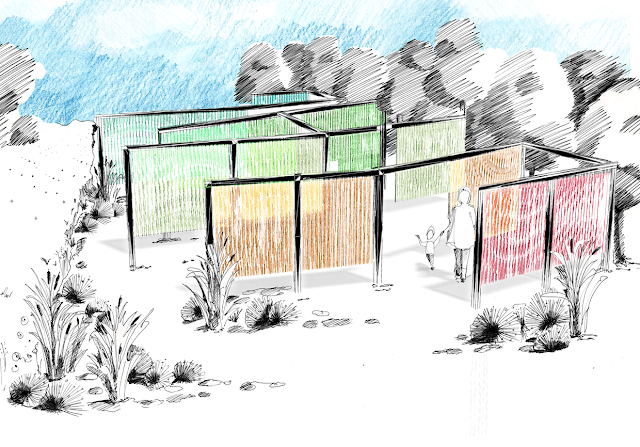An Interview
with
Heather Ring
The ALGAE Garden
Heather Ring
Snnove Fredericks
Brenda Parker
Jardins de Metis 2011
PO: Can you tell us about your practice?
HR: I'm a landscape architect, and the founder of Wayward Plants (www.waywardplants.org.uk) - a collective of designers, artists and urban growers that create spaces of exchange for plants, collecting stories and bringing together communities. Last summer, Wayward Plants designed and produced the Union Street Orchard (photo below) (www.unionstreetorchard.org.uk) for the London Festival of Architecture.
HR: I'm a landscape architect, and the founder of Wayward Plants (www.waywardplants.org.uk) - a collective of designers, artists and urban growers that create spaces of exchange for plants, collecting stories and bringing together communities. Last summer, Wayward Plants designed and produced the Union Street Orchard (photo below) (www.unionstreetorchard.org.uk) for the London Festival of Architecture.
Right now we're working on the follow-up, the Urban Physic Garden (www.physicgarden.org.uk) a pop-up apothecary and community-built garden of medicinal plants.
PO: Why did you apply to the Jardis de Metis?
HR: I think it's a great testing ground for ideas, and a launchpad for young designers. I actually interviewed the Montreal based landscape architecture collective, NIP Paysage, for Archinect.com - about how they got their start with a garden at Metis. (www.archinect.com/features/articles)
PO: What are the ideas behind the ALGAE GARDEN?
HR:The AlGAE GARDEN celebrates the beauty and productive potential of algae through a design that underlines its diversity and meaning.
This garden stands between the landscape, the artistic and the scientific world, presenting algae organized by colour and species in curtains of tubes hanging from steel frames. The spectrum ranges from reds to greens to bio-luminescent algae, which can glow a bright blue.
The algae, often considered a nuisance in the garden pond, here becomes an object of beauty and curiosity. The garden leads the visitor to appreciate algae both as an alternative to oil and other energy sources and a source of food and nutrition. Referencing a pond edge, the garden will be lined with pond grasses, and will display algae specimens, most that can be sourced locally.
The garden will explore the diversity of an often-overlooked plant, and demonstrate possibilities for how algae might become an evocative and productive part of our daily lives.
The ALGAE GARDEN is in collaboration with Synnove Fredericks, an artist and designer motivated by social interaction, specifically exploring our relationship with food, which led her to research spirulina algae in the nomadic gardens of refugee camps, and bacteria and yeasts for their nutritional value, and Brenda Parker, a scientist interested in how microorganisms can be used for environmental good: cleaning up arsenic from drinking water and remediating harmful chemicals. She is currently a postdoctoral researcher at the University of Cambridge, working as part of a team on the development of biofuels from algae.
This garden stands between the landscape, the artistic and the scientific world, presenting algae organized by colour and species in curtains of tubes hanging from steel frames. The spectrum ranges from reds to greens to bio-luminescent algae, which can glow a bright blue.
The algae, often considered a nuisance in the garden pond, here becomes an object of beauty and curiosity. The garden leads the visitor to appreciate algae both as an alternative to oil and other energy sources and a source of food and nutrition. Referencing a pond edge, the garden will be lined with pond grasses, and will display algae specimens, most that can be sourced locally.
The garden will explore the diversity of an often-overlooked plant, and demonstrate possibilities for how algae might become an evocative and productive part of our daily lives.
The ALGAE GARDEN is in collaboration with Synnove Fredericks, an artist and designer motivated by social interaction, specifically exploring our relationship with food, which led her to research spirulina algae in the nomadic gardens of refugee camps, and bacteria and yeasts for their nutritional value, and Brenda Parker, a scientist interested in how microorganisms can be used for environmental good: cleaning up arsenic from drinking water and remediating harmful chemicals. She is currently a postdoctoral researcher at the University of Cambridge, working as part of a team on the development of biofuels from algae.
Sustainability is the new buzz word in the gardening world. Heather Ring and the other members of her collaborative think about plants and gardens in a new way. Their activities are horticultural, but also political. Their gardens are contextual and turn our notions of what a garden is upside down. Without resorting to cliches, Heather Ring is redefining horticulture in the 21st. century.







 snap du jour (photo blog)
snap du jour (photo blog)





1 comments:
michael kors bags
kate spade outlet
ferragamo shoes
polo ralph lauren outlet
prada sunglasses
designer handbags outlet
ralph lauren uk
burberry bags
ralph lauren outlet online
michael kors outlet online
coach outlet store
ugg sale
yeezy 350 boost
polo ralph lauren
pandora charms
cheap ray bans
uggs
rolex watches
kate spade uk
armani exchange
oakley vault sunglasses
valentino outlet
nike huarache
adidas nmd white
puma shoes
ugg outlet
sac longchamp
coach factory outlet online
louis vuitton outlet
kate spade outlet online
omega watches
cheap nfl jerseys
coach outlet online
new balance outlet
coach factory outlet online
201685yuanyuan
Post a Comment